Reduced blood circulation and hypertension caused by cutaneous folds
People who suffer from blood circulation problems are told by medicine doctors that their blood vessels are responsible for their ailments because they've become too thick and stiff.
Grooming proves them wrong and shows that folds in the skin are the main cause of blood circulation troubles.
On this page
Your blood vessels get folded by your skin
Folds in your skin crush the collapsible blood vessels
Blood vessels are fairly compressible.
Putting even the slightest pressure on your skin crushes them and reduces their flow.
But, what happens when the skin itself is causing the compression because it has become folded and clamped to what is beneath it?
The skin squeezes and flattens the tiny vessels and cuts the flow in the veins and arteries.
| Human circulatory system - Wikipedia |
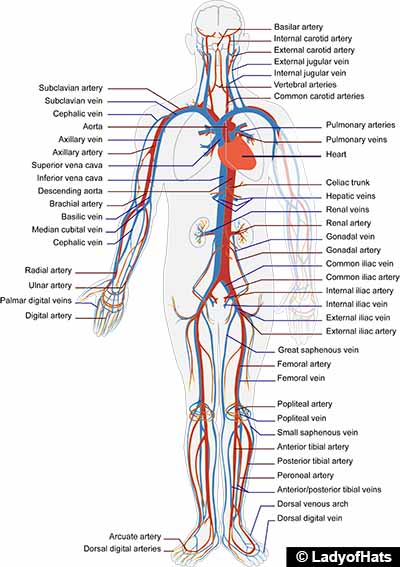
|
Folds in the skin cause global and local constriction
The pressure applied by your skin on your cardiovascular system can affect it in two ways:
• Global constriction; causing arteriosclerosis, high blood pressure or hypertension.
• Local constriction; causing atherosclerosis, numbness and tingling sensations.
Global constriction
As you age, your skin loses its elasticity.
It molds and takes the shape of what is beneath it.
The skin clinches and follows the contour of your blood vessels.
It hugs them so tightly that it puts some pressure on them.
The skin crushes the vessels and their flow is diminished.
As it hardens with age, and its folds become permanently etched in, the skin oppresses and weighs on the circulatory system more and more.

Local constriction
The skin of your body has developed large folds in many places, notably at each articulation.
Not only do these folds grow deeper all you life, they become permanent.
They cut into everything beneath them, including blood vessels.
When you do some movements, or even while you rest, the folds crush the vessels and their flow is diminished, even sometimes completely stopped.

Circulatory problems caused by cutaneous folds
Poor blood circulation
The folds in your skin have a constricting effect on your circulatory system.
All your articulations are surrounded by pleated skin with large folds that dig deep into what is beneath them.
The blood vessels that pass though these joints get bent, twisted, compressed and pinched every time you activate them.
Their flow is greatly reduced.
Folds in the skin isolate and leave entire regions behind.
Holding a position for hours or doing the same movement repeatedly only compounds the situation.
For example, the flow in the carotid arteries, supplying oxygenated blood to the brain, can be significantly reduced by keeping your head turned for even short periods.
| THE CAROTID ARTERIES |
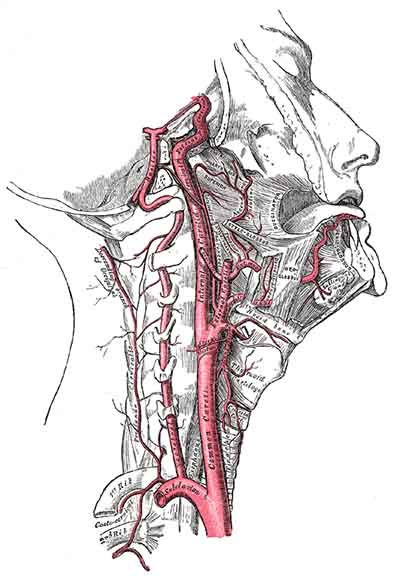 |
| Illustration: Henry Gray |
When the flow to the arms and legs is reduced or stopped, we experience the effects of paresthesia; numbness and the pins-and-needles effect.
However, when the flow to the head is affected, several other phenomenons can occur including dizziness, nausea, short-breath and headaches.
| Large cutaneous folds in the neck area affect the blood vessels beneath them |
 |
Blocked arteries or Atherosclerosis
The blockages occur where the arteries are bent by skin folds
Wikipedia
Atherosclerosis is medical condition where the inside of the arteries narrows because of a plaque build-up.
There are no known causes for this disease.
Grooming proves that cutaneous folds may be principally responsible for the narrowing of the arteries.
They crush, compress and narrow the flow of the arteries that they cross.
In fact, the plaque build-ups occur in places where the vessels are bent and kept folded by the skin.
| Folded arteries and veins Where do you think the plaque build-up occurs? |
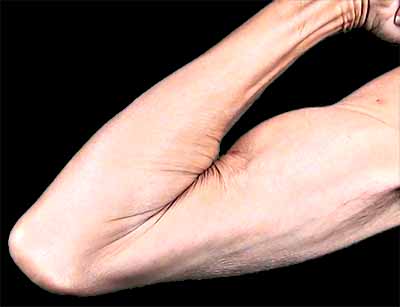 |
The arteries get badly battered and crumpled when they pass through some areas of your body, mostly the joints.
Your repeated moves and the positions you hold create deep folds in your skin and many of them have become permanent.
The constriction, that the folds apply, bends and deforms the arteries, hampers and cuts their flow and creates the proper conditions for plaque to build-up.
Doctors try to open up these vessels internally, but the problem could also be cured externally and naturally by grooming the skin of the affected area.
High blood pressure or Hypertension
The pressure that your skin exerts on your blood vessels can lead to hypertension
Capillaries are the tiniest blood vessels on your body.
Their diameter is similar to the width of a strand of spider web silk.
Capillaries not only drench the dermis, they climb up to the epidermis.
The veins that supply them with blood pass just beneath the skin.
All these vessels are easily crushed when you press on your skin, but their flow returns to normal as soon as they are freed.
However, when the skin becomes hardened with age and that permanent folds have formed, it continuously clamps and clings on your circulatory system; and your blood pressure goes up.
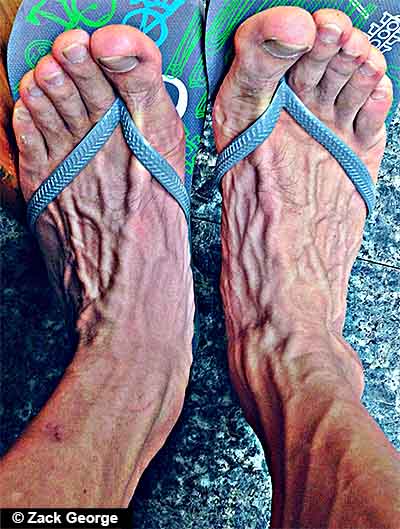
Your skin has lost some of its elasticity because you've never groomed it.
It clings so tightly to your circulatory system that it increases your internal pressure.
| Pressure taking |
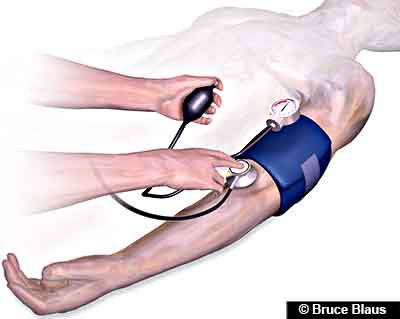 |
As you grow older, all your folds deepen and many become permanent.
They put more and more pressure on your aging blood vessels.
Every time your heart beats, its efforts to pump out the blood are constrained by the pressure the skin applies on the circulatory system.
This mostly affects the systolic pressure.
Numbness and tingling or Paresthesia
When your arms or legs fall asleep
We all undergo the discomfort of waking up with a dead member because our sleeping position has cut the flow of blood to that part of our body.
This can also happen when you're sitting (possibly with your legs crossed) or even standing.
When your position returns to normal, you feel some numbness at first, but as the blood rushes back to the region, you experience a painful tingling pins-and-needles sensation that slowly fades away.
This phenomenon is called paresthesia and it is happens when there isn't enough blood to supply the nerves.
| Paresthesia |
 |
In fact, it's the folded skin that's cutting the flow.
The blood vessels get folded along with the skin.
However, when permanent folds have formed, their presence reduces the flow continuously.
If you experience paresthesia frequently, grooming the large folds in the affected area may lessen or solve your problem.
Varicose veins or Spider veins
Cutaneous folds and their crossings block the flow in the veins
Wikipedia
Once again, scientists have no idea what causes varicose veins.
They say heredity, pregnancy, obesity, menopause, aging, prolonged standing, leg injury and abdominal straining can play a role.
What a joke!
Obviously, these people haven't pressed their fingers and nails into the affected skin or they would have found out that the skin is folded all over.
Cutaneous folds are to blame because they cut right through the veins.
However, the worst blockage occurs at the fold crossings.
They are like craters for the tiny vessels that get badly bent and mangled when they reach them.
Cutaneous folds cut the blood flow and this creates visible pools on one side of the blockage.
| VARICOSE VEINS |
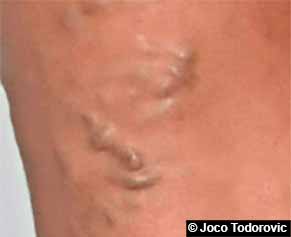 |
The veins aren't blocked because of faulty valves.
They are mechanically crushed by the folds in the skin itself.
You wont see most of those folds; they're made of epidermis over epidermis.
However, you can feel them easily with your nails and fingertips.
You're looking for the places where the obstructions have taken place.
The exact spots where the occlusions occurs may even be plainly visible.
Those locations are fold crossings and they can be very small.
At those points, the skin has pushed inwards deeply, creating a structure of tough, compacted cells, in the form of a hole or a bump, where the blood cannot pass.
The only way to get rid of those blockages is to crush those hardened elements away with your nail.
Blood clots or Thrombus
Blood clots occur where the skin is folded
Wikipedia
Platelets are a component of blood that reacts to blood vessel injury by clumping.
This is a normal response aimed at protecting the tissue; it only becomes a problem when the clots block the blood flow.
This internal process is very similar to an external one: the formation of coats of epidermis by your skin to protect itself from repeated folding.
Your blood vessels get repeatedly folded along with your skin when you move or hold a position.
At the point where the folding occurs, the vessels get badly crushed and mangled.
This could lead to injury, so the blood vessels react by thickening their walls.
I'm convinced that blood clots occur mostly in the places where cutaneous folds slice, bend and crumple the blood vessels.
How to restore the blood circulation
Free your circulatory system from the pressures of your skin
Grooming your skin can restore a normal blood flow to areas where the circulatory problems listed above have reduced or stopped it.
There are two main grooming techniques, you'll have to use them both:
• Superficial grooming; to restore the elasticity of the skin of parts of your body.
• Pressure grooming; to free the skin precisely where the blockages occur.
An introduction to human grooming
Human grooming lets you use your nails and fingertips to unfold your skin and free your blood vessels.
The following videos will get you started:

|
Human grooming rediscovered - Video |

|
The pain is in the skin - Video |
Superficial grooming; Reestablish the irrigation of large areas
Superficial grooming techniques can help in situations where the whole skin of an area, and not specific points, puts pressure on your blood vessels.
This can be the case mostly for high blood pressure and atherosclerosis problems.
The skin of the affected regions, or the whole body, has probably formed a thick cover composed of several coats of epidermis cells.
This coating hardens the skin and diminishes its flexibility.
With time, this external layer can hug and put continuous pressure on the circulatory system.
Removing this crust, and liberating your skin, with your nails will reduce the pressure.
Pressure grooming; Find and free the blockages with your nails and fingertips
Pressure grooming techniques can be very effective with many circulatory problems.
Since the folds and their crossings physically hamper the blood flow, opening up the folds with your nails removes their hold.
Superficial grooming should not represent more than 5% of your grooming activities, so the bulk of your efforts is made with pressure grooming.
As with pain or nervous troubles, you have to do some detective work to find out where the blockages are located.
But, unlike pain or nerves, blood vessels don't produce any feeling or clue that you're actually freeing them.
So, you have to work logically and go by trial and error.
Don't forget that the blood that goes out of the heart flows through the entire body (arteries) and back (veins), contrarily to the nerves that go one way up your back to your head.
Check out the main hurdles your blood encounters on its route: shoulder, elbow, wrist, hip, knee, .. articulations.
Some vessels can even be followed visually and in some cases, such as varicose veins, you can even pin-point the exact position of the blockage.
Use every bit of information and your intuition to locate the problems.
To discover those spots, peck the skin of the area repeatedly with short pressure strokes, while searching for the center of the hardened structures you encounter, where you apply long pressure stokes.

Be careful, go slowly and test-groom every area you work on.
Plan your grooming work over months, rather than days.
Don't forget that grooming the skin has many other benefits; such as removing pain and restoring beauty.
|
|
Next page
|